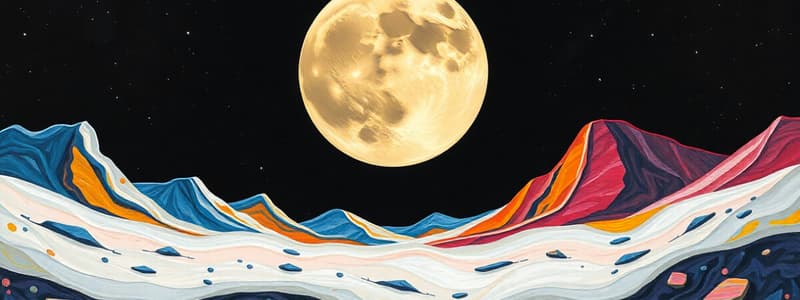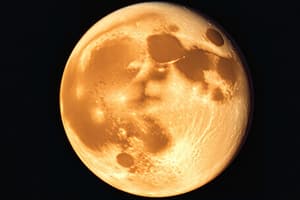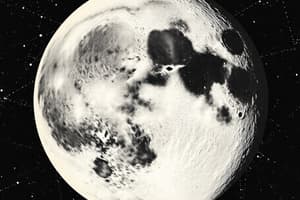Podcast
Questions and Answers
What is the primary cause of the Moon's heavily cratered surface?
What is the primary cause of the Moon's heavily cratered surface?
- Constant impacts from asteroids and comets throughout its history. (correct)
- Erosion caused by solar wind particles and micrometeorites.
- Tectonic plate movement resulting in surface fractures and basins.
- Volcanic eruptions that cooled and solidified over time.
What is the 'regolith' layer on the Moon primarily composed of?
What is the 'regolith' layer on the Moon primarily composed of?
- Pulverized rock and loose, powdery material resulting from impacts. (correct)
- A mixture of organic materials and frozen gases.
- Solidified lava flows from ancient volcanic activity.
- Dense sedimentary rock laid down by water over time.
Where is water ice most likely found on the Moon, and why?
Where is water ice most likely found on the Moon, and why?
- Underneath the regolith; from ancient liquid water stores on the surface.
- In the maria regions where lava flow created impermeable basins; protection of ice.
- In permanently shadowed craters near the poles; protected from solar radiation. (correct)
- In geologically active regions; heated by the core.
How does the thickness of the lunar crust differ between the highlands and the maria?
How does the thickness of the lunar crust differ between the highlands and the maria?
Which of the following best describes the formation of lunar regolith?
Which of the following best describes the formation of lunar regolith?
What is one of the primary minerals found in the lunar regolith that gives light color to many cratered regions?
What is one of the primary minerals found in the lunar regolith that gives light color to many cratered regions?
What can the frequency and distribution of impact craters tell us about the Moon?
What can the frequency and distribution of impact craters tell us about the Moon?
What possible process may contribute to the availability of water on the moon in addition to asteroid crashes?
What possible process may contribute to the availability of water on the moon in addition to asteroid crashes?
Flashcards
What is lunar regolith?
What is lunar regolith?
The powdery layer covering the lunar surface, formed by constant bombardment by asteroids and comets, consisting of pulverized rock fragments and minerals.
What is the lunar crust?
What is the lunar crust?
The outer layer of the moon, thicker in the highlands and thinner in the maria, comprised primarily of anorthosite, a dense igneous rock.
What is cratering on the Moon?
What is cratering on the Moon?
A process where impacts from asteroids and comets carve out craters on the lunar surface, influencing the shape and age of various regions.
What are craters on the moon?
What are craters on the moon?
Signup and view all the flashcards
What is Cryovolcanism?
What is Cryovolcanism?
Signup and view all the flashcards
What is water ice on the moon?
What is water ice on the moon?
Signup and view all the flashcards
Why is the lunar crust different between highlands and maria?
Why is the lunar crust different between highlands and maria?
Signup and view all the flashcards
What does lunar regolith contain?
What does lunar regolith contain?
Signup and view all the flashcards
Study Notes
Lunar Surface Characteristics
- The Moon's surface is heavily cratered due to impacts from asteroids and comets over billions of years.
- These craters vary greatly in size, from microscopic pits to vast basins.
- The lunar surface is primarily composed of pulverized rock and regolith, a layer of loose, powdery material.
- The regolith, a significant component, covers much of the visible surface.
- This fine, dusty layer is a result of relentless bombardment throughout the Moon's history.
- The Moon's lack of atmosphere and geological activity means its regolith layer has remained largely unchanged.
Cryovolcanism and Water Ice
- Evidence suggests water ice exists in permanently shadowed craters near the lunar poles.
- This ice is shielded from harsh solar radiation by the perpetual darkness of these regions.
- Cryovolcanism could be a source of water ice if volcanic activity involves water.
- The presence of water ice is significant for future lunar exploration and resource utilization.
- These potential water ice deposits could provide water for future lunar bases and spacecraft fuel.
Lunar Crust
- The lunar crust is thicker in the highlands than in the maria.
- This thickness difference reflects the Moon's layered structure.
- The lunar crust's composition differs from Earth's, containing different amounts and types of minerals.
- The crust is largely made of dense, igneous rocks, primarily anorthosite.
- The lunar crust is about 60 km thick in the highlands, thinner in the maria.
Regolith Layer Composition
- The regolith is a complex mixture of minerals and fragments of varying sizes.
- It's a product of the impact process, breaking down larger rocks into smaller ones.
- Chemical analysis reveals a rich source of materials in lunar regolith.
- Minerals like plagioclase feldspar, giving light color to many cratered regions, are found within it.
- Regolith forms as impacts break up rocks into progressively smaller pieces.
Cratering Processes
- Cratering is a major geological process shaping the lunar surface.
- The frequency and distribution of impact craters provide insights into the Moon's past.
- The number and size of craters help understand the age of particular regions.
- Different crater sizes indicate varying impactor sizes.
- Impacts with varying projectile speeds and angles create distinctive crater morphologies.
Terminology & Context
- "Crusted snow" on the Moon is not actual snow.
- The presence of ice, potentially resembling "crusted snow," is found in permanently shadowed craters.
- Descriptions like "Moon of crusted snow" likely refer to the Moon's polar regions suspected of containing water ice.
- "Crusted snow" is a figurative description for icy regions on the Moon.
- "Moon of" is a poetic/literary expression, not a scientific label.
Studying That Suits You
Use AI to generate personalized quizzes and flashcards to suit your learning preferences.




